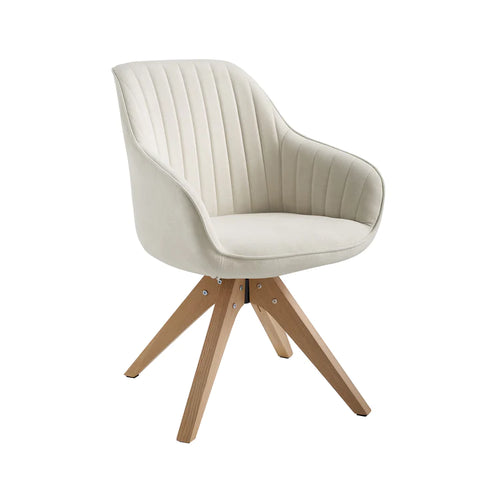
When it comes to furnishing a living space, achieving a harmonious blend of furniture is essential. One common consideration is the relative heights of a sofa and an accent chair. While it is often assumed that a sofa should sit higher than an accent chair, it is important to note that this depends on various factors.
|
Contents[hide]
|
-
Design and Style:
One of the primary factors determining the seating height is the inherent design and style of the furniture pieces. Sofas can come in various styles, such as traditional, classic, modern, or minimalistic. Traditional or classic-style sofas typically have higher seat heights, while modern or low-profile designs tend to be lower. Accent chairs, too, have diverse styles, each with a unique seat height. Therefore, when selecting furniture of complementary heights, it is crucial to consider the design aesthetics and intended look of the space.
-
Ergonomics and Comfort:
Comfort and the intended purpose of the furniture are significant influencers of seat height discrepancies. Sofas, often used for lounging, relaxation, and entertaining, are commonly designed with higher seat heights. This facilitates easier sitting and standing, providing better support to a wider range of individuals. In contrast, accent chairs offer more versatility, as they can serve various functions and cater to different preferences. Consequently, accent chairs may come in varying seat heights to accommodate specific needs, be it reading, chatting, or as decorative pieces.
-
Proportional Considerations:
In addition to design and function, the proportional relationship between furniture pieces affects the perceived height. The scale and dimensions of the furniture come into play here. A large, bulkier sofa placed next to a smaller accent chair will naturally appear taller, even if their seat heights are similar. Depending on the overall layout and arrangement of the room, these proportional differences can influence the visual perception of the seating heights.
-
Personal Preference:
Ultimately, personal preference is a crucial aspect of selecting furniture. Some individuals may have a preference for a sofa that offers better back support and promotes an upright seating position. In such cases, a higher seat height may be desirable. However, others might prefer accent chairs with higher seat heights due to personal comfort or the need for additional cushioning.
Measure Carefully Before Buying Your Furniture: Tips for a Successful Purchase
Before you begin measuring, take a moment to assess your room and envision how you want it to function. Consider existing furniture and the flow of foot traffic. This assessment will help you determine the type and quantity of furniture you need, as well as any potential constraints or limitations within the space.
- 2. Measure the Room:
Using a measuring tape or laser measure, measure the dimensions of the room. Start with the length and width of the walls, ensuring accuracy down to the nearest inch or centimeter. Note any architectural features such as alcoves, windows, or columns, as these can affect the placement of furniture.
- 3. Consider Clearance and Traffic Flow:
Take into account the clearance space required for comfortable movement around the furniture. Aim for at least 2-3 feet (60-90 cm) of space between pieces and around pathways. This ensures that the room feels open and allows for easy navigation without feeling cramped.
- 4. Measure Doorways and Entry Points:
While measuring the room is important, don't forget to measure the doorways and entry points leading into the room. Confirm that your chosen furniture will fit through these openings, accounting for both the width and height of the doors. This step ensures a smooth delivery process and avoids any unfortunate surprises.
- 5. Account for Existing Furniture:
If you have existing furniture that you plan to keep, consider its measurements and how it will fit with the new pieces. Allow enough space for all items to coexist comfortably, ensuring a cohesive and well-organized arrangement.
- 6. Create a Furniture Layout:
Using graph paper or online design tools, create a scaled floor plan of your room. Include the measurements of walls, windows, and doors. Then, experiment with different furniture layouts by placing scaled furniture templates on the plan. This exercise allows you to visualize how different pieces will fit together and helps you determine the optimal arrangement.
- 7. Light and Ventilation Considerations:
If you have windows or light fixtures, take note of their placement and any clearance needed around them. Similarly, ensure that ventilation systems such as air conditioning units or radiators have sufficient space to function properly without being obstructed by furniture.
- 8. Measure Furniture Dimensions:
When shopping for furniture, always check the product specifications for accurate measurements. Pay close attention to the width, height, depth, and any other relevant dimensions that may affect its fit in your space. Compare these dimensions to your room measurements and layout to ensure a proper fit.
We recommend:
Conclusion:
When deciding on the height relationship between a sofa and an accent chair, it is crucial to consider multiple factors. The design and style of the furniture, the ergonomics and comfort levels, proportional considerations, and personal preference all play significant roles in determining the appropriate seating heights. Remember, there is no definitive rule stating that a sofa should always sit higher than an accent chair. By carefully evaluating these factors and combining them with your unique preferences, you can create a harmonious blend of furniture that not only looks aesthetically pleasing but also provides comfort and functionality.



